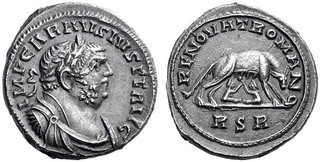This record is provided by CoinArchives, a database of numismatic auction catalogs.
Important copyright information:
The data below is presented by permission of the copyright holder(s). Reproduction is allowed only by authorization from Numismatica Ars Classica.
Important copyright information:
The data below is presented by permission of the copyright holder(s). Reproduction is allowed only by authorization from Numismatica Ars Classica.
| Numismatica Ars Classica > Auction 62 | Auction date: 6 October 2011 |
| Lot number: 2083 | |
| Lot description: The S.C. Markoff Collection of Roman Coins The Roman Empire Carausius, 286 – 293 Denarius, Londinium circa 287-289, AR 4.94 g. IMP CARAVSIVS P F AVG Laureate, draped and cuirassed bust r. Rev. RENOVAT ROMANO She-wolf standing r., suckling Romulus and Remus; in exergue, RSR. C 293. RIC 571. Shiel 68. Very rare and in exceptional condition for the issue, possibly the finest denarius of Carausius in existence. A very attractive portrait struck on an unusually good metal with a delightful old cabinet tone. Extremely fine Ex NFA sale XX, 1988, 459. Carausius was a man of considerable talent who rose from humble origins in Menapia, a seafaring region between the Waal and the Scheldt rivers, to achieve command of the Channel Fleet and, ultimately, to found his own empire. Whether Carausius abused his authority over the Channel fleet or he was a victim of false accusations, the issuance of an arrest warrant caused the new commander to believe his only chance for survival was to stage a revolt, using Britain as his base. After making landfall and forging agreements with the Scots and the Picts, Carausius defeated the army of the Roman governor Quintus Bassianus and absorbed many of those soldiers into his own army. He was in a good position at the start of his revolt, for he had an expert knowledge of the waters surrounding the island, there were many new fortresses along the Saxon shore, and Maximianus was distracted by persistent warfare on the Rhine. This gave Carausius a chance to develop his philosophy of governance, which included copying much of what he admired about the Roman Empire and its ancient institutions. This denarius, for example, celebrates the foundation of Rome by portraying the she-wolf suckling Romulus and Remus. It goes a step further with the inscription RENOVAT ROMANO, which presents his own enterprise as an effort to restore the greatness of a bygone era. It is easy to recognise why Maxentius, a nobleman who later would revolt in Rome, adopted this approach to his public messages, but it is remarkable that a provincial of humble origin would attempt this in a remote corner of the empire. In the process, Carausius spared no aspect of empire-building: he hosted Saecular Games, held consulships and even assumed the titles pontifex maximus and pater patriae. His success did not long endure, though. In 293 the emperors Diocletian and Maximian each adopted a Caesar, with Constantius I being assigned in the West. Constantius' main purpose seems to have been recovering the lost territories, and his initial efforts expelled Carausius from his possessions in Gaul. He also terrified the rebel's Frankish allies so greatly that Carausius' sphere of influence was effectively reduced to Britain. Upon returning to the island, Carausius was murdered and replaced by his chief minister Allectus, who survived three years before he was defeated in a daring invasion of Britain by which Constantius brought an end to the rebel state. Estimate: 30000 CHF |  |


